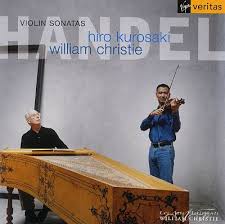 You may be familiar with classic recordings of George Frideric Handel’s Violin Sonatas by Isaac Stern, Nathan Milstein, Henryk Szeryng and Szymon Goldberg. For the most part, they’re all Romantic performances, emphasizing a large, singing tone and lots of vibrato. For a slightly different take, add to the list an excellent 2003 Baroque recording by violinist Hiro Kurosaki and harpsichordist William Christie.
You may be familiar with classic recordings of George Frideric Handel’s Violin Sonatas by Isaac Stern, Nathan Milstein, Henryk Szeryng and Szymon Goldberg. For the most part, they’re all Romantic performances, emphasizing a large, singing tone and lots of vibrato. For a slightly different take, add to the list an excellent 2003 Baroque recording by violinist Hiro Kurosaki and harpsichordist William Christie.
No one knows if Handel actually wrote all seven of the sonatas on this disk. A few are suspected to be the work of other composers, now long forgotten. The D-major sonata (HWV 371), one of Handel’s last works, and youthful G-major sonata (HWV 358) are authentic. Dr. Suzuki included the F major and D major sonatas in Book 6 and the A major sonata in Book 7.
Born in Japan, Hiro Kurosaki now lives in Austria and teaches at the Mozarteum in Salzburg. He plays a 1690 Giovanni Battista Rogeri violin on this recording, an instrument made during Handel’s lifetime. Kurosaki and Christie claim that their interpretation was influenced by Handel’s opera writing. Listen to this excerpt from the 1724 opera, Giulio Cesare, for a comparison.
Here is Sonata No. 4 in D major:
https://www.youtube.com/watch?v=AEGCVh7U_bg
Also listen to the F major and G major sonatas.
[unordered_list style=”tick”]
[/unordered_list]

